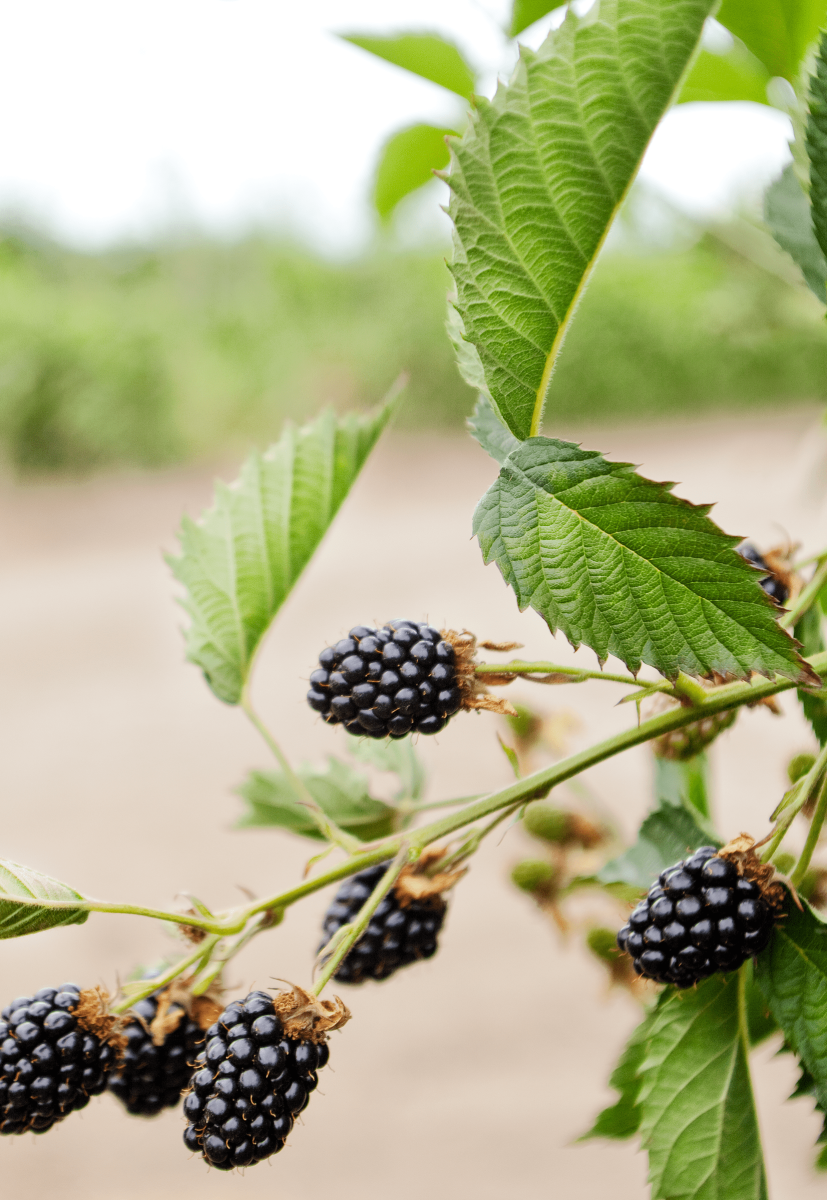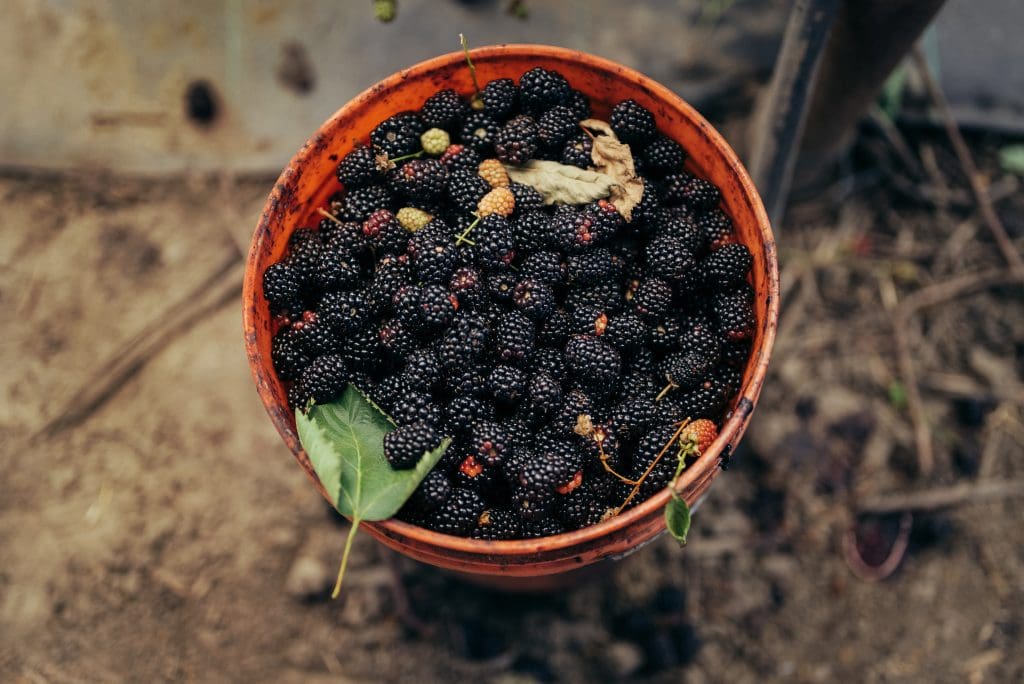Berry lovers unite
Join our community for tasty recipe ideas, handy hints, seasonal fun facts and more.

May 13, 2025 in Berry News
Cooked in a recipe, preserved in jam or perfect on their own, sweet but tart blackberries are a common favourite. The deliciously juicy and plump blackberry has been enjoyed over time, not only as a sweet treat but also as a natural dye or a treatment for illnesses like gout. We explain the history of the blackberry, the differences between wild and store bought blackberries and how to grow your own!
The blackberry has been around for centuries. As part of the Rubus Genus (just like Raspberries) from the Rosaceae family, the blackberry is a perennial plant and grows in what is commonly known as brambles. Blackberries and raspberries differ by the core, a raspberry has a hollow core whilst a blackberry has a ‘torus’ which stays with the fruit after being picked.
It’s tough to pinpoint exactly where blackberries originate from, but they likely came from temperate regions in the Northern Hemisphere before spreading across the globe due to colonisation. Blackberries were thought to be a part of the hunter-gatherers’ diets across the world, and many indigenous (including Native Americans) have eaten blackberries for centuries. One of the earliest known instances of humans enjoying blackberries is estimated to be from approximately 500 BC. A well-preserved body of an Iron Age woman, known as The Haraldskær Woman, was found in a Danish bog and her stomach contents revealed a diet of millet and blackberries.
Blackberries arrived in Australia around 1840 from Europe. They were first promoted as a great source of edible fruit and used to help control soil erosion. But due to their dense thickets, and ability to quickly dominate vegetation and exclude native plants, wild blackberry plants are now considered a weed.
Aside from eating, blackberries have had numerous uses throughout history. From dyeing fabrics to making wines, blackberries have been a source of inspiration for humans and have proven to be highly useful.

One of the main traditional uses of blackberries is as a natural dye. Not only do the berries of blackberries yield beautiful purple, pink and grey colours for dyeing, but so do the cane and leaves. Pigment from blackberries was used in illuminations, a type of book from the Middle Ages which were enhanced with stunning decorations and illustrations. Blackberries have also been an important part of British folklore and are thought to have helped to protect against incantations and curses. October 10th is Old Michaelmas Day, also known as Devil’s Spit Day, which is the last day you should pick your blackberries before they are fouled by evil spirits!
Blackberries have long been used for medicinal reasons in various cultures. In ancient Greece, blackberries were used to cure gout and sore throats. It is also reported that Romans brewed tea made from blackberry leaves to treat a range of different illnesses. However, in the 16th century blackberries suffered a hit in popularity as many gastronomy and medical books touted blackberries as the cause of ‘bad moods’ and suggested avoiding them. While many rural classes continued to eat blackberries, they only returned to popularity in the late 18th century. They continue to be considered healthy and therapeutic, with the root of blackberries being believed in helping to relieve dysentery as well as stomach ulcers.
People have enjoyed blackberries in multiple different forms and recipes throughout history. Tonics and wines were made from blackberries, with blackberry wine becoming particularly popular in the Middle Ages as a more affordable substitute for beer and mead.
The London Pharmacopoeia from 1696 declared that blackberries make a great cordial and are ‘restorative of the spirit’. Jellies made from blackberries were common in the early 1700s and could be enjoyed with both savoury and sweet meals. Blackberry jam continues to be hugely popular, and it first emerged around the 1880s after the increased supply of sugar. The dark purple jam was eaten to enhance the taste of dark wholemeal bread consumed by the working classes.
As mentioned before, blackberries are a weed found in the wild across Australia, although they are most commonly found in south-eastern New South Wales. You can legally forage for berries, but be careful when picking in National Parks (which is not allowed) and if on private property (it’s always best to ask for permission first). You will find that cultivated blackberries tend to be slightly sweeter than those found in the wild, this is because store bought berry varieties have been carefully selected and grown with care. If you want to ensure that your blackberries are juicy, sweet and slightly tart then you can pick up some Driscoll’s blackberries from your local grocery store or supermarket.
You can forage for wild blackberries and eat the fruits of your labour if you know what to look for! A blackberry bush will have thick thorny branches which can grow up to two metres in height and seven metres long. The leaves are made of three to five egg-shaped dark green leaflets, which are compound leaves that are not directly borne from the main stem. Blackberries will initially be green in colour, before ripening to red then black. In the case of being unsure whether you’ve picked a blackberry or a different type of berry, it’s best to discard it and not eat it.
To ensure a regular supply of blackberries, you can grow your own! As blackberries grow quickly and widely, growing them in pots or containers is an easy way to ensure they stay manageable and don’t take over your garden. Blackberries need a position with full sun with moist, well-drained and slightly acidic soil. You can further enrich the soil by adding manure or compost and applying a berry-specific fertiliser every 8-12 weeks.
The blackberry fruit will form on two year old canes. After they have finished fruiting ensure to cut them down as they will not fruit again.
You can find more information about blackberries and how to enjoy them on our blackberry page.